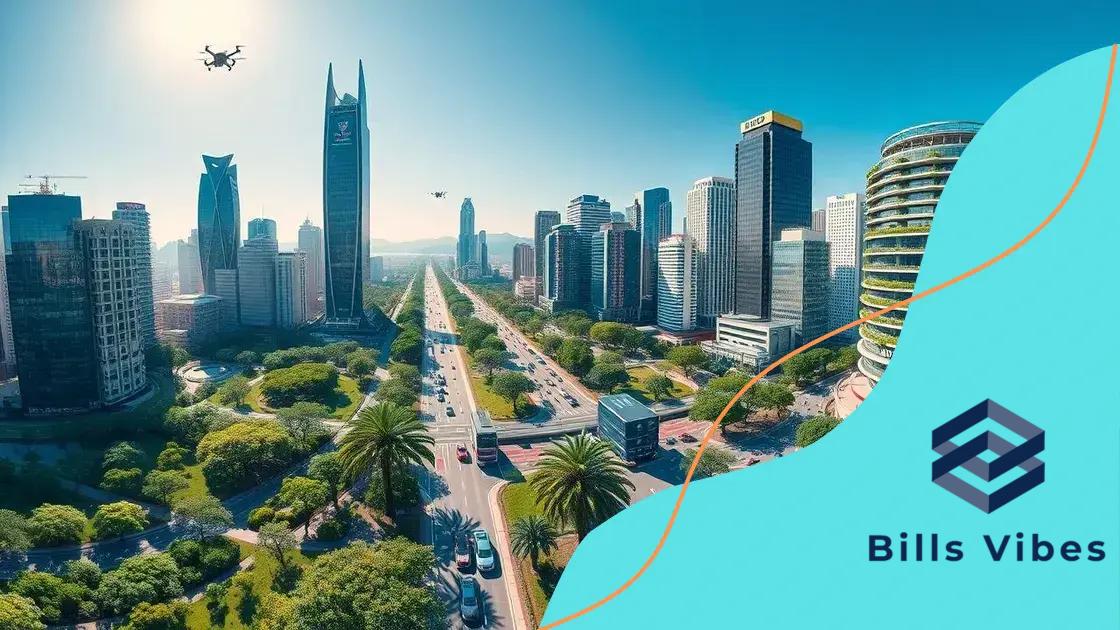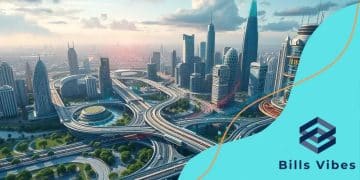Smart cities expansion: are we ready for the future?

Smart cities utilize technology and data to enhance urban living, promoting sustainability and community engagement while addressing challenges like funding and technology integration.
Smart cities expansion is reshaping how urban spaces function and thrive. From improving sustainability to enhancing quality of life, these changes prompt us to think about their implications on our everyday lives.
Understanding smart cities and their importance
Understanding smart cities is vital in today’s rapidly evolving urban landscape. These cities harness technology to improve the quality of life for their residents. By integrating various digital technologies, they streamline services and optimize resource use.
Key Features of Smart Cities
One important aspect of smart cities is their focus on sustainability. In addition to improving utility efficiency, they foster better community engagement.
- Use of IoT devices to monitor traffic and air quality
- Smart public transportation systems
- Efficient waste management solutions
- Renewable energy initiatives
These features not only enhance urban life but also contribute to environmental health. The success of a smart city depends on its ability to adapt and engage its citizens. By encouraging participation in decision-making, residents feel more connected and empowered.
The Role of Technology
Technology plays a crucial role in enabling smart city initiatives. With advancements in big data and artificial intelligence, cities can analyze vast amounts of information to make informed decisions. This leads to efficient public services and improved resident satisfaction.
Furthermore, technology helps create a safe environment. Features like smart street lighting, surveillance systems, and emergency response apps ensure that cities remain secure. As we move forward, the concept of smart cities will continue to evolve, driven by innovation and the collective ambition to create better urban spaces.
Key technologies driving smart city expansion
Key technologies play a crucial role in driving smart city expansion. These advancements not only enhance urban living but also optimize resource management. Cities are increasingly leveraging various tools to improve functionality and resident engagement.
Internet of Things (IoT)
The Internet of Things is a fundamental technology in smart cities. By connecting devices, cities can monitor systems in real-time. This leads to better traffic control, energy conservation, and waste management.
- Smart streetlights that adjust brightness based on traffic
- Connected sensors in waste bins to optimize collection routes
- Traffic cameras that provide data for congestion management
- Environmental sensors that monitor air quality
As these devices gather data, city planners can make informed decisions based on real-time information.
Big Data and Analytics
Another important aspect is the use of big data and analytics. By analyzing vast amounts of data, cities can determine patterns and trends. This helps in predicting needs and enhancing public services. Smart cities use data to assess everything from traffic flows to energy consumption, leading to smarter resource allocation.
Moreover, big data can facilitate community engagement by informing residents about city projects and changes. When people are informed, they are more likely to participate in civic activities.
Artificial Intelligence (AI)
Artificial intelligence adds another layer of intelligence to urban management. AI algorithms can analyze data to enhance services such as public safety and transportation. For example, predictive policing uses data to allocate police resources effectively.
As AI continues to evolve, it opens new opportunities for automation and efficiency in city management. From emergency response systems to traffic light management, AI is paving the way for a more connected urban experience.
Challenges faced by urban planners

Urban planners face numerous challenges when implementing smart city initiatives. These challenges can hinder progress and affect the overall effectiveness of urban development. Understanding these obstacles is crucial for creating sustainable and vibrant urban environments.
Funding and Budget Constraints
One of the primary challenges is securing adequate funding. Many smart city projects require significant investment in technology and infrastructure. Urban planners often struggle to allocate budgets effectively among various initiatives.
- Finding investors for innovative projects
- Balancing traditional infrastructure needs with new technologies
- Managing limited public funds for expansive initiatives
- Ensuring long-term financial sustainability
Without stable funding, many projects may be delayed or scaled back, preventing cities from realizing their full potential.
Technology Integration
Another major challenge is the integration of diverse technologies. Cities often rely on multiple platforms and systems that can complicate communication and data sharing. For smart cities to function smoothly, these systems must be interconnected.
This integration can be difficult, especially when dealing with different vendors and service providers. Compatibility issues might arise, leading to inefficiencies and frustrations.
Public Resistance
Community acceptance plays a significant role in the success of smart city initiatives. Some residents may be resistant to change, fearing loss of privacy or increased surveillance. Educating the public about the benefits of technology is essential for overcoming these concerns.
Effective communication strategies can help engage the community in urban planning discussions. By involving citizens, planners can address fears and create solutions that reflect community needs.
Data Security and Privacy
As cities rely more on data, ensuring security and privacy becomes paramount. Urban planners must navigate complex regulations to protect residents’ information. Any breach could undermine trust in smart city technologies.
Urban planners need to establish clear data usage policies and ensure compliance with privacy laws. Failing to address these concerns can lead to public backlash, hampering progress.
The role of citizens in smart cities
The role of citizens in smart cities is crucial for the success of urban initiatives. Involving the community ensures that urban development meets the needs and preferences of its residents. Citizens are not just users of city services; they are active participants in shaping their environments.
Participation in Decision-Making
Citizen participation in decision-making processes allows for a more inclusive approach to city planning. When residents have a say, projects are more likely to reflect their concerns and aspirations.
- Community meetings to discuss urban planning projects
- Surveys to gather feedback on proposed initiatives
- Collaboration on neighborhood improvement plans
- Involvement in pilot programs for new technologies
When citizens engage in these processes, they help create solutions that are genuinely beneficial to the community.
Activism and Advocacy
Citizens also play an essential role as advocates for their neighborhoods. They can raise awareness about local issues, such as transportation needs or environmental concerns. Activism can drive positive changes that align with the goals of smart cities.
Through social media and local groups, residents can organize campaigns to support initiatives that enhance urban life. This strengthens the community and creates a sense of ownership among residents.
Utilizing Technology
Technology empowers citizens to participate actively in their cities. Various apps and platforms allow residents to report issues, provide feedback, and access information easily. For instance, apps enabling residents to monitor air quality can encourage civic engagement in environmental initiatives.
Moreover, technology fosters transparency between city officials and residents. Open data initiatives enable citizens to access vital information, promoting accountability and trust.
Civic Responsibility
Citizens in smart cities also have a responsibility to contribute positively to their communities. This includes volunteering for local projects, attending community events, and actively participating in discussions about urban development.
When communities unite for a common purpose, they can create vibrant, resilient urban spaces that enhance the quality of life for everyone.
Future trends in urban development
Future trends in urban development reflect the growing need for cities to adapt to changing lifestyles and technologies. As populations grow and urban areas expand, innovative approaches will shape how cities develop.
Sustainable Design
Sustainable design will become a cornerstone of urban development. This includes using eco-friendly materials and promoting green spaces. Cities are increasingly recognizing the value of sustainability in reducing environmental impact.
- Incorporating green roofs and walls in buildings
- Creating urban forests and community gardens
- Developing renewable energy sources, like solar power
- Implementing efficient waste management systems
As cities embrace sustainability, residents can enjoy healthier environments.
Smart Infrastructure
Smart infrastructure is another key trend that will drive urban development. This refers to the use of technology to improve city services and efficiency. With advancements in smart technology, urban planners can enhance life for all citizens.
Examples include smart traffic lights that adjust to real-time conditions and connected public transportation systems that provide accurate arrival times. These innovations make cities easier to navigate and more efficient.
Mixed-Use Developments
Mixed-use developments combine residential, commercial, and recreational spaces. They promote a sense of community and reduce reliance on transportation. Future cities will likely continue developing mixed-use spaces that foster interaction and creativity.
With everything within walking distance, residents can enjoy vibrant neighborhoods that support local businesses and lifestyles.
Resilience Planning
Resilience planning is gaining importance as cities face challenges from climate change and natural disasters. Urban planners must develop strategies to make cities adaptable to changing conditions.
Examples of resilience strategies include building flood defenses and creating emergency response plans. By prioritizing resilience, cities can protect their residents and property during extreme events.
FAQ – Questions about smart cities and urban development
What are smart cities?
Smart cities are urban areas that leverage technology and data to improve city services, enhance living conditions, and promote sustainability.
How can citizens contribute to smart city initiatives?
Citizens can participate by providing feedback, engaging in community meetings, and advocating for local projects that improve their neighborhoods.
What challenges do urban planners face in developing smart cities?
Planners often encounter challenges such as securing funding, technology integration, and public resistance to changes.
What trends can we expect in future urban development?
Future trends include sustainable design, smart infrastructure, mixed-use developments, and resilience planning to adapt to environmental changes.






